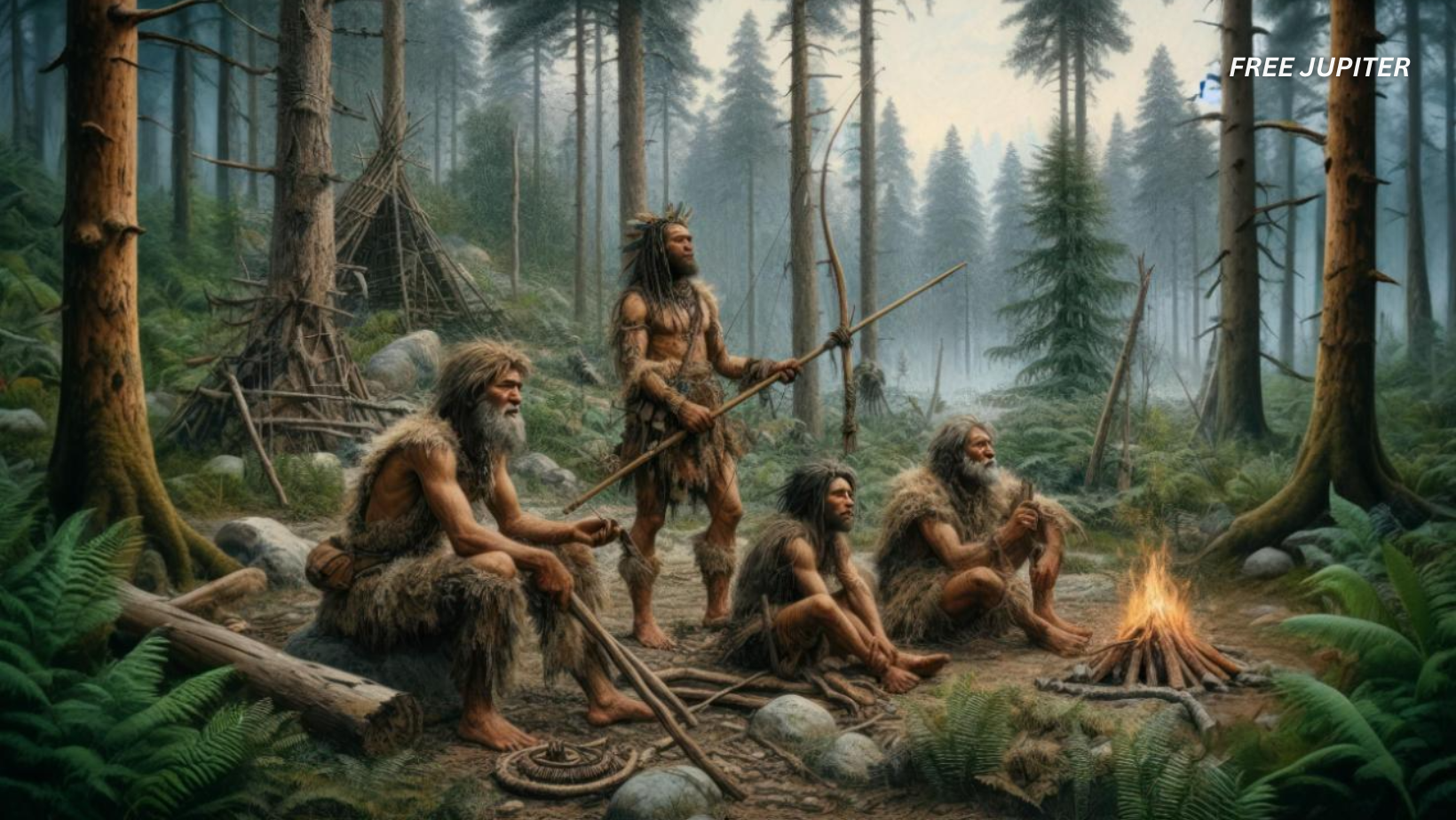Friendly Note: FreeJupiter.com shares general info for curious minds 🌟 Please fact-check all claims—and always check health matters with a professional 💙
The saga of the first humans to inhabit the Americas is a compelling chronicle of endurance, adaptation, and extraordinary migration across vast and challenging terrains. Recent advances in genetic research and archaeology have significantly deepened our understanding of this journey, which began in northern Asia and culminated in the diverse Indigenous populations spread across North and South America. Central to this story is the Bering Land Bridge, a now-submerged landmass that once connected Siberia and Alaska during the last Ice Age, serving as a vital corridor for early human migration.
The Bering Land Bridge: A Crucial Passageway
During the Pleistocene epoch, particularly throughout the last Ice Age, global sea levels dropped dramatically—by as much as 300 feet—due to the extensive glaciation that trapped vast amounts of Earth’s water in ice sheets. This drop exposed a landmass known as Beringia, stretching roughly 1,000 miles from north to south and up to 600 miles wide at its peak, connecting present-day eastern Siberia with Alaska’s Seward Peninsula. This expansive region provided a tundra-like ecosystem rich in plant and animal life, including large mammals such as mammoths and bison, which early humans likely hunted or followed.
Archaeological and genetic evidence suggests that humans began crossing this land bridge between 24,500 and 14,800 years ago during brief windows when the corridor was ice-free and passable. These early migrants were hunter-gatherers who relied on the availability of local resources to survive the harsh conditions. The Bering Land Bridge theory, first proposed in the late 16th century and refined over centuries, remains the most widely accepted explanation for the initial peopling of the Americas.
Genetic Evidence Supports a Prolonged Stay in Beringia
One of the most intriguing findings from recent genetic studies is the support for the Beringian standstill hypothesis. This theory posits that the ancestors of Native Americans spent thousands of years isolated in Beringia, adapting to its unique environment before dispersing southward. For example, the complete mitochondrial genomes of two infants buried near Fairbanks, Alaska, about 11,500 years ago, reveal genetic lineages still present in Indigenous populations across the Americas today.
This prolonged habitation was likely due to massive ice sheets blocking southward migration routes until around 14,000 years ago. During this standstill, populations adapted to the tundra environment, coexisting with Ice Age megafauna and developing cultural and technological innovations necessary for survival.
Read more: Astronomers Are Baffled by a Space Object Flashing in Both Radio Waves and X-Rays
Archaeological Corroboration: Clovis Points and Early Sites
Archaeological evidence complements the genetic data. The discovery of Clovis Points—distinctive stone spearheads associated with the Clovis culture—across North America, dating back roughly 12,000 to 14,000 years, indicates a rapid expansion of human populations following the opening of ice-free corridors. These spearheads demonstrate advanced hunting techniques and suggest a widespread cultural tradition among early Americans.
Additional sites in Alaska and northern Canada, some dating back at least 15,000 years, provide further evidence of early human presence in the region. These finds suggest that once the ice sheets receded, humans moved quickly southward, adapting to diverse environments ranging from Arctic tundra to temperate forests.
Multiple Migration Waves and Routes
While the land bridge provided a terrestrial route, recent research suggests that early humans may have also used coastal pathways, traveling by boat along the Pacific Rim. The “kelp highway” hypothesis proposes that rich coastal marine ecosystems offered abundant resources, enabling migration into the Americas even before the inland ice-free corridor became accessible.
Genetic analyses reveal that the peopling of the Americas was not a single event but involved multiple waves of migration from different parts of Asia, including northern coastal China. This complexity is reflected in the genetic diversity observed among Indigenous populations today.
The Ice Wall Challenge and Maritime Migration
New geological studies have identified a nearly 1,000-meter-high ice wall that once blocked the Bering Land Bridge, challenging earlier assumptions about migration routes. This enormous ice barrier, comparable in height to a 300-story building, likely prevented overland migration during certain periods, pushing early humans to explore maritime routes across the Bering Strait.
Oregon State University researchers propose that the first Americans may have used boats to cross the narrow sea passage when the land bridge was impassable. This theory is supported by archaeological finds of stone tools on islands in the Bering Strait and Alaska, indicating advanced maritime capabilities among groups such as the Paleo-Inuit or Arctic Small Tool tradition peoples.
Read more: Japan Shatters The Internet Speed Barrier – With Speeds of 402 TBPS Over Regular Fiber
Genetic Bottlenecks and Disease Susceptibility
As early migrants journeyed from Asia into the Americas, they carried only a subset of the genetic diversity of their ancestral populations. This bottleneck effect reduced variation, especially in immune-related genes, potentially making Indigenous populations more vulnerable to infectious diseases introduced by later arrivals, such as European colonists. Understanding these genetic patterns provides valuable insights into the resilience and vulnerabilities of contemporary populations[original article].
Cultural and Environmental Adaptations in the Americas
Once in South America, early human groups diversified into distinct populations adapted to varied environments. These included communities in the Amazon basin’s dense rainforests, the dry Chaco region, Patagonia’s icy fields, and the high valleys of the Andes Mountains. This broad ecological adaptation underscores the remarkable flexibility and ingenuity of early humans in colonizing new and challenging landscapes.
Archaeological finds such as cave paintings and ornaments crafted from extinct megafauna bones offer glimpses into the cultural life of these early inhabitants, highlighting their creativity and deep connection to their environment[original article].
Related Article: The Bering Land Bridge Theory and Its Archaeological Evidence
The Bering Land Bridge theory remains a cornerstone in understanding the earliest human migration to the Americas. This theory posits that during the last Ice Age, lowered sea levels exposed a land corridor—Beringia—connecting Asia and North America. Humans likely crossed this bridge between 12,000 and 14,000 years ago, living off the plants and animals that thrived there during their journey.
Evidence supporting this theory includes the widespread discovery of Clovis Points—stone spearheads crafted by early inhabitants of the Americas—which mark some of the earliest known human activity on the continent. These artifacts demonstrate sophisticated hunting technology and a rapid spread of populations after crossing Beringia.
Alternative theories exist, such as coastal migration routes and maritime crossings, but the land bridge remains the most widely accepted explanation. Archaeological sites in Alaska and northern Canada, along with genetic data, continue to reinforce the importance of Beringia as a migration corridor. Despite being submerged today, the Bering Strait holds archaeological treasures that may one day further illuminate this ancient journey.
Read more: 23-Year-Old Ukranian Discovers Way To Make Paper From Fallen Leaves Without Cutting Down Trees
Conclusion
The peopling of the Americas is a story of extraordinary human endurance, marked by complex migration patterns, environmental challenges, and cultural innovation. The Bering Land Bridge served as a vital gateway, enabling early humans to traverse from Asia into the New World. Genetic and archaeological evidence reveals a prolonged habitation in Beringia, multiple migration waves, and remarkable adaptability to diverse environments.
Recent discoveries of ice barriers and maritime migration possibilities add new dimensions to this narrative, illustrating the dynamic nature of human history. These insights not only deepen our understanding of human evolution but also honor the rich heritage of Indigenous peoples whose ancestors undertook this remarkable journey. As research advances, the story of humanity’s spread across the globe becomes ever more detailed, connecting us all through a shared past.










